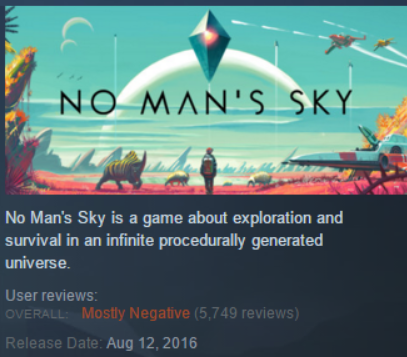
Three days after its PlayStation 4 launch, the space-exploration game No Man's Sky is now live for Windows PC gamers (via either Steam or GoG). But if you've been anywhere near PC gaming for the past few years, you won't be surprised to find out that combining "small development team," "video game that promises 18 quintillion planets," and "worldwide simultaneous launch on all kinds of PCs" is a dangerous mix.
The game's Steam reviews, which have surpassed 5,700 as of press time, are sampling out as "mostly negative," with frequent complaints about framerate hitches and total system crashes. Though Steam's reports must be considered anecdotal, more than a few trustworthy voices are piping up online to report issues with No Man's Sky, despite using systems that far exceed the game's minimum spec, which calls for older cards like the GTX 480 and Radeon 7870. Even users with high-end solutions like the GTX 1080 or two GTX 980Ti cards in SLI mode are reporting major stutters—on a game that runs on a comparatively so-so PS4 console with a mostly consistent 30 FPS refresh.
Ars Technica is running two NMS test sessions on high-end PCs at the moment, and both of them are running GTX 980Ti cards with SSD drives, 16GB of RAM, and either a Skylake i5 or a Haswell i7 Intel chip. We're seeing inconsistent framerates, in spite of both computers in question having fully updated drivers on Windows 10. The game's PC version defaults to a 30 FPS cap, which can be disabled in the normal options menus. But with this setting turned on, the game can't help but hitch down to an apparent 20 FPS on a regular basis, not to mention throw up frequent display hitches of half a second at a time. Removing that framerate cap can get play up to a smooth 60 frames per second, and we enjoyed more consistent framerates without the cap. But even those framerates can bounce down to 30 or less at random intervals. The game also suffers from freezing hitches, even without apparent spikes in visible geometry like creatures or spaceships.







